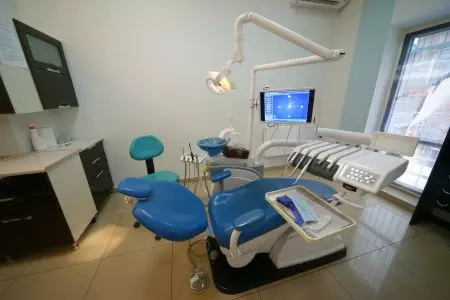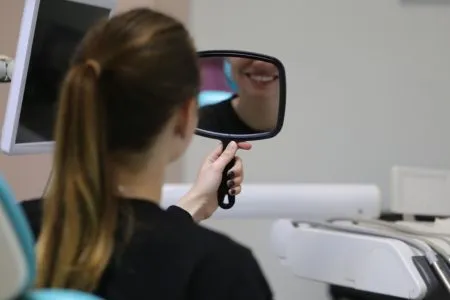- Tooth extraction: indications, methods, recommendations
- Indications for tooth extraction
- How a tooth extraction works
- Contraindications to tooth extraction
- Advice after a tooth extraction
- How to reduce pain after a tooth extraction
- Advantages of dental treatment at the Dent-House Family Dentistry Clinic
- How much does it cost to extract a tooth in Odessa?
- Frequently asked questions about tooth extraction
- Specialists
- Make an appointment
TOOTH EXTRACTION
Tooth extraction
A surgical procedure in dentistry to extract a tooth from the dental alveolus.
Indications for tooth extraction are divided into emergency and planned. The need for emergency extraction arises in acute purulent inflammation spreading to the bone (periostitis, osteomyelitis), phlegmons, abscesses, sinusitis, lymphadenitis, when the tooth is not subject to conservative treatment or does not represent functional value, as well as in severe tooth pain, when adequate treatment is impossible, if the crown part of the tooth can not be restored by filling or prosthetic treatment. Teeth in the jaw fracture line.

Indications
- Teeth with impassable root canals with
chronic peri-root periodontitis, cysts,
especially complicated by maxillary sinusitis, neuralgia. - Failure to save a decayed tooth.
- Third and fourth degree tooth mobility in
periodontitis. - Atypical position of wisdom teeth or other teeth,
which traumatise the mucous membrane, interfere with
foodintakeand speech function. - Overcompensated and retained teeth causing
pain or inflammation. - Mechanical damage to the tooth (root fractures).
- Tumours of the jaw.
- In preparation for or during orthodontic
treatment. - During prosthetic treatment (single
teeth that interfere with the stabilisation of the prosthesis). - Diseases in which it is not possible
to treat and restore the tooth with the support of its own
root, and recommended extraction with subsequent
implantation and prosthetics (significant
carious destruction, periodontitis – inflammation of tissues,
adjacent to the roots of teeth, root fractures,
mechanical traumato thetooth, periodontal disease, etc.).
Treatment planning with an orthopaedic dentist is done in advance of the removal.
The patient is referred for radiography and (or) computed tomography of the jaws to determine the structure of the tooth and bone tissue, the location of anatomical formations.
In most cases, tooth extraction is performed under local anaesthesia. Modern anaesthetics allow to carry out the manipulation painlessly and as delicately as possible. If necessary, on indication, intraoperative support by the anaesthesia service in the form of anaesthesia or sedation (medication sleep) is possible.
Main types of extraction
Wisdom tooth extraction
Removal of retained and distorted teeth
Tooth extraction: indications, methods, recommendations
Unfortunately, sometimes even modern dentistry cannot cope with some oral problems. Tooth extraction is one of the forced measures. Dentists resort to it only in extreme cases. If you need to remove a tooth, the price in each case will be formed individually. It depends on the complexity of the procedure, the cost of equipment, the work of the doctor and other factors. Thanks to modern equipment, methodology and highly qualified doctors, the procedure is easy and painless. It is important to turn to professionals – choose specialists from the Dent-House Family Dentistry Clinic.
Indications for tooth extraction
Tooth extraction (exodontia) is the surgical removal of a tooth from the alveolus. The reasons why a doctor recommends surgery are varied. The most common are:
- excessive tooth decay that cannot be replaced by a prosthetic tooth;
- an abnormal growth of the tooth that makes it impossible to place a crown;
- end-stage periodontitis;
- trauma and tumours of the jaw;
- trauma to the tooth roots;
- teeth with periodontal disease, cysts;
- complications of maxillary sinusitis that affect the teeth;
- severe inflammation or infection;
- a fractured tooth root;
- a tumour of the alveolar process;
- position or trauma to the teeth, which interfere with diction, normal eating and regularly traumatise the oral mucosa;
- during orthodontic treatment;
- significant carious lesions;
- atypical positioning of the wisdom teeth.
Tooth extraction can be planned or emergency. Only a dentist can decide whether to perform the operation.
In the future, the extracted tooth must be replaced, otherwise it will lead to shifting of the tooth row, bite disorder, diction, and GI problems. Most often, doctors suggest implant placement.
Sometimes tooth extraction is also required in children. Most often these are baby teeth that for some reason have not fallen out on their own and are preventing the growth of permanent teeth.
How a tooth extraction works
Tooth extraction requires prior preparation. Initially, the doctor sends the patient for a CT scan, which shows the condition of the bone tissue and tooth structure. Next, standard analyses are required.
It is not allowed to drink alcohol or smoke before the operation. As for food, it is possible and even necessary to eat before the operation (if it is a local anaesthesia).
Tooth extraction can be simple or complex:
- The first method is used to remove teeth that are clearly visible in case they can be securely fixed. Then the tooth is grasped with a special tool – forceps, swung and extracted from the hole. If the tooth is multi-rooted, the dentist first divides it into elements using a drill and then extracts it.
- The second method is used when a tooth is completely or partially located under the gum. Most often, these are wisdom teeth, as well as other retained and dystopian teeth. They occupy an incorrect position, as a result of which they press on neighbouring teeth and cause inflammatory processes. The price of this procedure is higher than the previous one.
To operate on complex cases, the doctor needs to cut the gum and then extract the tooth completely or in parts. If necessary, the hole is sutured.
Usually, both simple and complex procedures are performed under local anaesthesia. However, if the surgical procedure is too complex, if several teeth are going to be extracted or if the patient is panic-stricken about surgery, the dentist may recommend treatment in sleep.
For questions about how much it costs to pull a tooth and how long the procedure takes, you will be counselled in advance.
Contraindications to tooth extraction
Like any surgical procedure, the tooth extraction procedure has its contraindications. These include:
- blood clotting problems;
- certain cardiovascular diseases;
- acute infections;
- exacerbation of chronic illnesses;
- certain neurological conditions;
- elevated body temperature.
Tooth extraction is not recommended if you are pregnant.
Advice after a tooth extraction
Tooth extraction is not an easy operation. After surgery, you may experience pain, facial swelling, and sometimes fever. The healing process usually takes about 5 days. To minimise the effects and speed up recovery, it is recommended:
- Reduse from eating in the next 2-3 hours after removal. Thereafter, give preference to liquid food. Warm food, refusal of spicy and salty foods is also recommended. Do not chew on the side where the operation was performed.
- Do not use drinking tubes.
- Do not brush your teeth or rinse your mouth for the first 12 hours after surgery. Carefully perform hygiene procedures thereafter.
- Refrain from heavy physical exertion for 2-3 days after surgery. It is also not allowed to visit a sauna, or take flights for a month.
- Do not touch the wound yourself.
- Abstain from alcoholic beverages.
It is also mandatory to take medications prescribed by a doctor.
If you are concerned about severe pain, bleeding, excessive swelling, or other symptoms after surgery, be sure to see your doctor.
How to reduce pain after a tooth extraction
After coming off anaesthesia, the patient may experience pain. This is usually a nagging or sharp pain. There is also sometimes discomfort in the throat or when swallowing or opening the mouth. To reduce discomfort, it is recommended to apply a cold compress to the area of the operation (10-15 minutes with breaks every 2-3 minutes). It can be repeated after some time. This procedure will help to avoid swelling.
It is also recommended that you take painkillers and do not sleep on the side where the surgery was performed.
In case of acute unbearable pain, consult a dentist.
Advantages of dental treatment at the Dent-House Family Dentistry Clinic
To have your tooth extracted without a hitch, contact Dent-House dentistry. This is a clinic in Odessa, whose doctors cope with even the most complicated cases. The risks of complications are minimal.
Why you should come to us:
- A wide range of services. In our dental clinic in Odessa you can cure tooth decay, whiten teeth, put braces and veneers. We also work with children – we put coloured fillings, correct the bite and perform other dental manipulations.
- Personalised approach. Every case is special. That is why we prepare an individualised treatment plan for the patient.
- Professional equipment. This allows any complex procedures to be carried out.
- High-quality specialists.Our doctors are professionals with extensive experience. In addition, doctors constantly improve their qualifications and participate in various seminars and forums.
- Sterility. We use the latest equipment to sterilise instruments and regularly disinfect the clinic.
- Loyalty programme. Thanks to our wide range of materials, we offer patients the opportunity to adjust the price of treatment to suit them. We also offer a permanent system of promotions.
- Interior. You will not feel the atmosphere of a hospital with us – the interior is cosy and modern. Each room is decorated thematically. There is also a foyer, a separate patio and a relaxation area.
Our dentistry will appeal to people who value comfort, safety, and their time.
How much does it cost to extract a tooth in Odessa?
It is difficult to name the exact cost of tooth extraction in our clinic in Odessa, as each case is different. The price of the operation in the clinic “Dent-House” depends on the amount of work and other related factors and starts from 1200 UAH for baby tooth.
If you are scheduled for a root extraction, the price may increase in some cases. Atypical tooth extraction involves additional procedures, such as making incisions in the gum. The hole may need to be sutured for faster healing. The cost of complex tooth extraction in our clinic starts from 2000 UAH, atypical – from 2500 UAH.
You can find out the approximate cost of treatment from the receptionist. Call the phone numbers listed in the “contacts” section and make an appointment for a consultation or appointment at any convenient time. Having introduced yourself with the site in more detail, you can find out prices, read reviews and study the programme of services for seafarers.
Frequently asked questions about tooth extraction
🦷 What are the methods of tooth extraction?
😁 What are the possible consequences of removal?
🦷 Are there any special instructions after the procedure?
Cost of services
Procedure | Cost |
|---|---|
🦷 Removal of a baby or loose tooth | from 1000 UAH |
⭐ Simple tooth extraction
| from 1400 UAH |
🦷 Complex tooth extraction | from 2000 UAH |
⭐ Atypical tooth extraction | from 2500 UAH |
🦷 Removal of an impacted tooth | from 4000 UAH |
Specialists

Beda Valery Nikolayevich
Implant surgeon
Course of the procedure

Tooth extraction is preceded by a thorough diagnosis: the dental surgeon determines the number of tooth roots, their length, shape and the position of neighbouring teeth using X-ray data. Only on the basis of these data the doctor decides how the operation will be performed. If a tooth has two, three or more roots, it can be sawn into parts, after which each root is removed separately. This allows the operation to be carried out gently, preserving as much as possible the amount of bone tissue necessary for further successful and painless implantation.

In the case of extracting retained teeth, the doctor makes an incision in the mucosa (if necessary, forms a hole in the bone tissue with a bur), then extracts the tooth completely or in parts. In such a case, it is necessary to close the hole after the operation.




